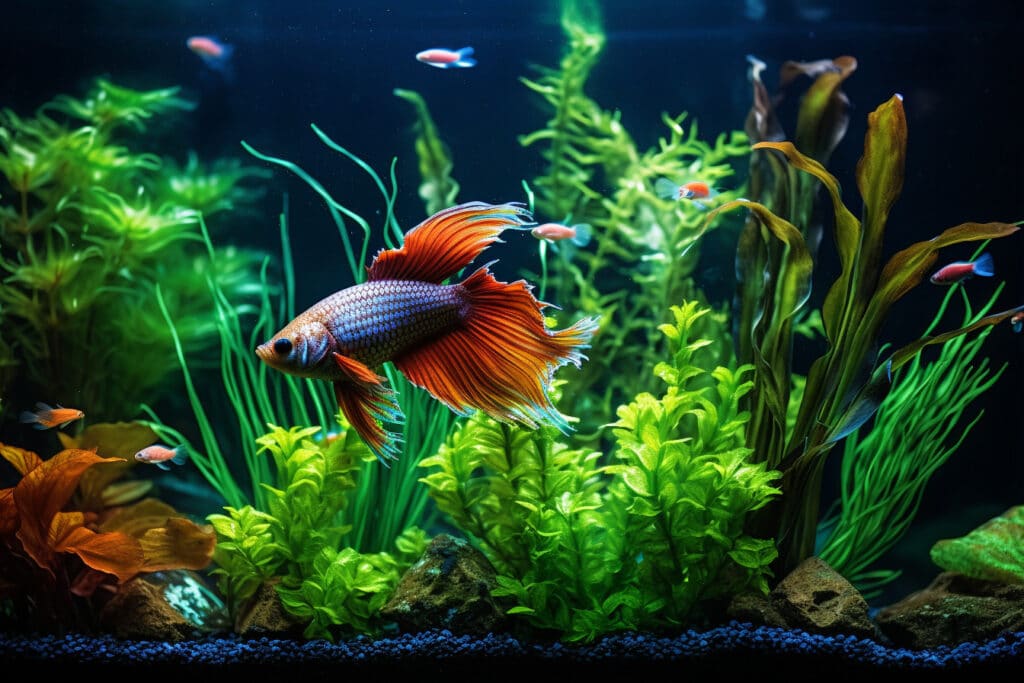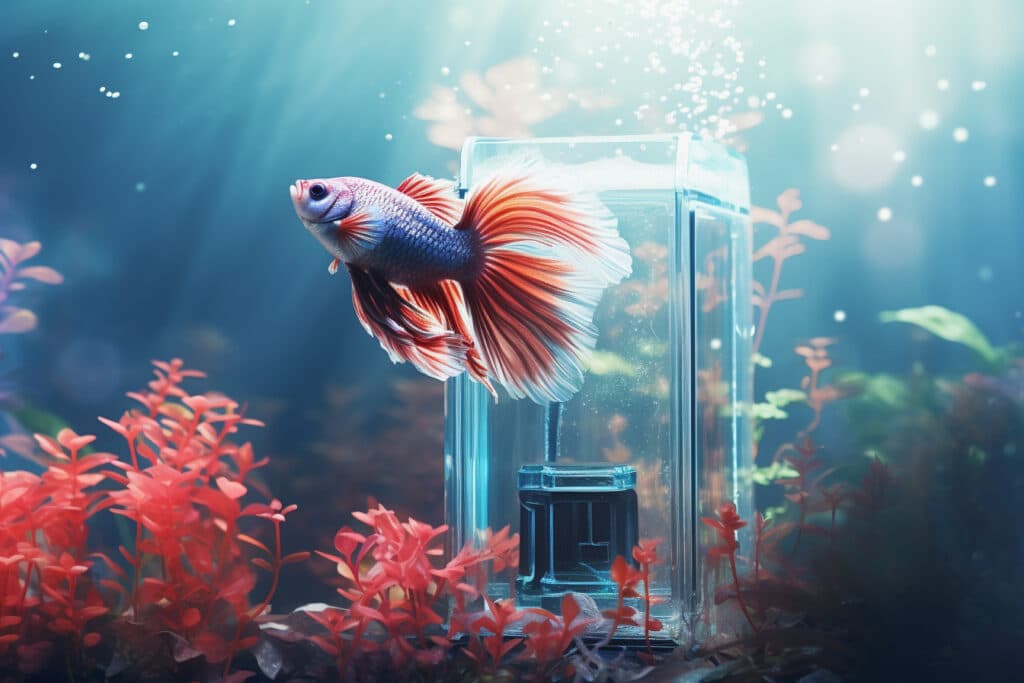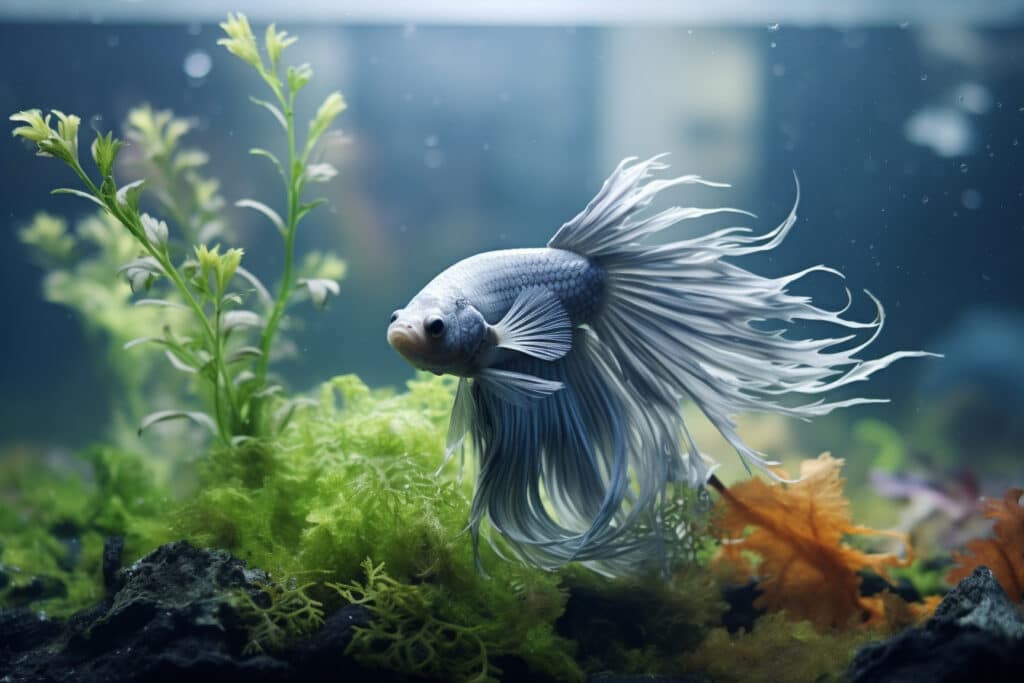How Big Do Betta Fish Get?
So, How Big Do Betta Fish Get?, Welcome to the mesmerizing world of Betta fish, Also known as the Siamese fighting fish or Betta splendens.

These captivating creatures come in a remarkable range of sizes, each with its unique charm. From tiny little bettas that can comfortably fit in the palm of your hand to majestic beauties that showcase impressive dimensions.
Let’s embark on a journey to uncover the secrets behind the sizes of Betta fish and delve into the wonders that await us in their underwater realm.
Table of Contents 🦑

How Big Do Betta Fish Get, The Size Spectrum
The Betta fish, exhibit a fascinating array of sizes that can vary significantly among different individuals and specific betta species.
Common Betta Fish Sizes
On the smaller end of the spectrum, we have the petite bettas, measuring around 2 inches in length. These adorable miniatures are incredibly delicate and charming, perfect for those who appreciate the elegance of a compact aquatic companion.
Moving up the size ladder, we encounter the average-sized bettas, which typically reach a length of 2.5 to 3 inches. These bettas strike a balance between petite and large, showcasing the quintessential characteristics of the species while providing a visually pleasing presence in their aquatic habitat.
For those seeking grandeur and magnificence, the larger bettas steal the spotlight. These impressive specimens can grow up to 3.5 inches or even more, boasting flowing fins and vibrant colors that command attention. Their graceful movements and striking appearance make them the center of attention in any aquarium.
Scaling Up: From Delicate Beauties to Impressive Giants
Baby Betta Fish: When betta fish are young, they are typically around 1 to 1.5 inches in length. These baby bettas are often sold in pet stores and require special care and feeding to support their growth.
Juvenile Betta Fish: As betta fish mature, they go through a growth phase, and their size gradually increases. Juvenile bettas can range from 2 to 2.5 inches in length. During this stage, they develop their vibrant colors and characteristic finnage.
Adult Betta Fish: Fully grown adult betta fish can reach an average size of 2.5 to 3 inches in length. However, it’s important to note that bettas can vary in size within this range. Some may be smaller, around 2 inches, while others may grow larger, up to 3.5 inches.
Giant Betta Fish: Giant bettas are a selectively bred variety known for their larger size. These bettas can grow significantly larger than the average betta fish, ranging from 3.5 to 4.5 inches or even more. They have longer bodies and fins, making them quite impressive to behold.
It’s important to remember that betta fish sizes can vary based on individual genetics, care, and other factors mentioned earlier. Providing them with a suitable environment, proper nutrition, and optimal care can help them reach their maximum size potential. Regular observation and monitoring of their growth will allow you to appreciate their unique beauty as they grow into their full size.
Whether you opt for a dainty miniature betta, an average-sized beauty, or a majestic large betta, each size category offers its own unique allure and charm. The key is to find the perfect betta that suits your preferences and the available space in your aquarium.
Male vs. Female Size Showdown

When it comes to betta fish, there’s a noticeable difference in size between males and females. Male betta fish often steal the spotlight with their stunning appearance and larger size. Let’s dive into the male vs. female size comparison and explore the remarkable differences.
Male betta fish, with their vibrant colors and flowing fins, are the epitome of beauty and elegance. They showcase an impressive size that can range from 2.5 to 3 inches (6.35 to 7.62 cm) on average, making them slightly larger than their female counterparts. The males’ long and elaborate fins contribute to their majestic appearance, creating a mesmerizing display as they gracefully swim through the water.
On the other hand, How Big Can A Female Betta Fish Get? Female bettas have a more understated beauty but are equally captivating in their own right. They tend to have a more streamlined body shape with shorter fins compared to the males. The average size of female bettas ranges from 2 to 2.5 inches (5.08 to 6.35 cm), making them slightly smaller than the males.
The size difference between male and female bettas is not only visible but also serves a purpose in their natural behavior. Male bettas need larger sizes and elaborate fins to attract and impress potential mates during the breeding process. Their impressive size and vibrant colors help them establish dominance and protect their territory.
While the size difference between males and females is apparent, it’s important to note that individual variations exist within each gender. Not all males will reach the maximum size, and not all females will be at the minimum size range. Factors like genetics, nutrition, and overall health can influence their growth and size potential.
Whether you have a male or female betta, each one possesses its own unique beauty and charm. Embrace and appreciate the differences in size, colors, and fins as they add to the allure of these remarkable fish.

6 Tips to Make Your Betta Fish Grow Bigger
To help your betta fish grow to a fully grown betta fish and reach their full size potential, there are several key factors to consider. Here are some tips to promote their growth:
Proper Nutrition
Providing a balanced and nutritious diet is essential for betta fish growth. Offer a variety of high-quality commercial betta fish pellets or flakes as their main staple. Supplement their diet with live or frozen foods such as brine shrimp, daphnia, or bloodworms to provide additional protein and nutrients.
Ensure you feed them the right amount and avoid overfeeding, as excessive weight gain can hinder growth.
Tank Size
Betta fish require adequate space to swim and grow. Provide a spacious tank that meets their minimum requirements. Larger tanks, such as those with a capacity of 5-10 gallons or more, allow your betta to move around freely and exercise, promoting healthy growth.
A larger tank also provides a more stable environment and dilutes any harmful substances, ensuring optimal conditions for growth.
Water Quality
Maintaining clean and pristine water conditions is crucial for betta fish growth. Regularly test the water parameters and ensure they fall within the appropriate range for bettas. Perform routine water changes to remove any accumulated toxins or waste. Use a water conditioner to eliminate harmful chemicals and maintain a stable pH level.
A clean and well-maintained environment supports healthy growth and prevents stress-related issues.
Temperature and Lighting
Betta fish are tropical fish and thrive in warm water temperatures between 78-80°F (25-27°C). Use a reliable aquarium heater to maintain a consistent temperature within this range. Additionally, provide appropriate lighting conditions by using a timer to simulate a natural day-night cycle
Adequate lighting and temperature create an optimal environment for betta fish growth.
Enrichment and Exercise

Betta fish need mental stimulation and physical exercise to thrive. Add aquarium decorations, plants, and hiding spots to create an engaging and stimulating environment. Provide enough space for them to swim freely and explore their surroundings.
Regular exercise contributes to muscle development and overall growth.
Stress Reduction
Minimize stress factors that can hinder growth. Avoid overcrowding the tank with too many tank mates or aggressive fish that may cause stress.
Keep a peaceful and harmonious environment for your betta. Additionally, avoid sudden changes in water conditions, temperature, or introducing new tank decorations too quickly. Gradual transitions and a stress-free environment support healthy growth.
Remember, betta fish have their own unique growth rate, and genetics also play a role in determining their size.
It’s essential to provide a suitable environment, proper nutrition, and optimal care to give your betta fish the best chance to grow bigger and healthier. Observe their behavior, monitor their growth progress, and consult with a veterinarian or experienced betta enthusiast if you have any concerns about their growth or overall well-being.
Nurturing Growth Through Nutrition
Proper nutrition plays a vital role in promoting healthy growth for your betta fish. To support their development and ensure they reach their full size potential, it’s important to provide a well-rounded diet. Here are some tips for offering nutritious meals that nurture your betta’s growth:
Varied Food Options: Betta fish are carnivorous and thrive on a diet rich in protein. While betta fish eat pellets or flakes food types, it’s essential to provide variety. Supplement their diet with live or frozen foods like brine shrimp, daphnia, or bloodworms. These foods offer essential nutrients and mimic their natural diet in the wild. By diversifying their meals, you ensure they receive a wide range of nutrients necessary for growth.
Portion Control: Feeding your betta fish the right amount is crucial for their growth and overall health. Overfeeding can lead to obesity, which can hinder growth and lead to various health issues. Offer small portions that your betta can consume within a few minutes. Monitor their eating habits and adjust the portion size accordingly. Remember, it’s better to slightly underfeed than overfeed.
Frequency of Feeding: Betta fish have small stomachs, so frequent feeding is important to meet their nutritional needs. Feed them small meals 2-3 times a day. This schedule helps maintain their metabolism and provides a steady supply of nutrients for growth. Be consistent with feeding times and avoid long periods without food to ensure their nutritional requirements are met.
Quality Fish Food: Invest in high-quality fish food specifically formulated for bettas. Look for reputable brands that offer a balanced nutritional profile. Check the ingredients list to ensure it contains essential nutrients such as proteins, fats, vitamins, and minerals. Avoid low-quality or generic fish foods that may lack the necessary nutrients for optimal growth.
Supplement with Fresh Foods: Alongside commercial fish food, you can supplement your betta’s diet with fresh foods. Offer small portions of finely chopped vegetables like peas or spinach, as these provide additional vitamins and fiber. Ensure the vegetables are thoroughly washed and blanched to remove any potential toxins before feeding them to your betta.
By providing a well-rounded diet with varied food options, portion control, and a balanced feeding schedule, you are nurturing your betta fish’s growth. Remember to observe their eating habits, adjust the feeding routine as needed, and monitor their overall health.
With proper nutrition, you’re giving your betta the best chance to grow healthy, vibrant, and to their fullest size.

In Conclusion
Understanding how to help your betta fish grow bigger is a combination of providing the right environment, proper nutrition, and attentive care.
By offering a well-rounded diet, maintaining optimal water conditions, providing adequate space, and reducing stress factors, you can nurture your betta’s growth and help them reach their full potential. Remember, each betta fish is unique, and their growth rate may vary.
Embrace the journey and appreciate the beauty of your betta’s growth, knowing that you are providing the best care possible.
Thank you for joining us on this exploration of Betta fish growth.
We hope this guide has provided valuable insights and practical tips to support your betta’s development.
By creating a nurturing environment and taking the necessary steps to ensure their well-being, you can foster the growth and happiness of your single betta fish.
If you have any further questions or need assistance, feel free to reach out. Happy betta fish keeping!
Related Blog Posts:

Do Betta Fish Need A Filter
Do Betta Fish Need A Filter? One of the main questions we get is “Do

How Long Can Betta Fish Go Without Food?
Swim To 🤿 Home How Long Can Betta Fish Go Without Food? In the bustling

Why Is my betta fish not eating
Swim To 🤿 Home Why Is My Betta Fish Not Eating Why is my betta
